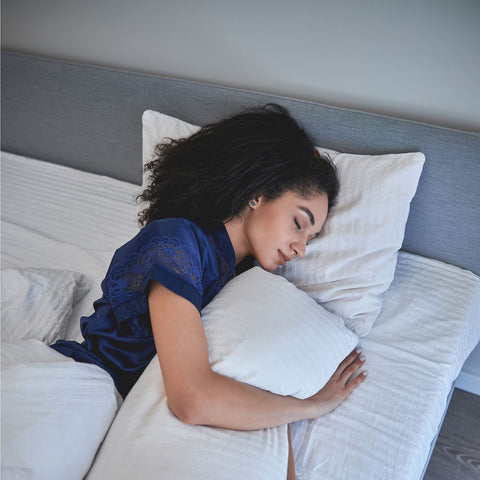The way you sleep has a profound impact on your physical health, particularly when it comes to neck comfort and spinal alignment. Using two pillows may seem like it provides extra cushioning, but it can actually lead to problems. If you frequently wake up with a sore neck, the number of pillows you use might be a factor to consider.
The structure of your neck and the health of your spine are at the forefront of debates concerning pillow use during sleep. While some sleepers may feel more comfortable elevating their head with multiple pillows, this habit can cause the neck to rest at an unnatural angle, potentially straining muscles and ligaments. It's important to understand the relationship between your sleeping position and pillow usage to minimize any risk of discomfort or lasting pain.
Choosing the right pillow is more than a matter of personal comfort—it's about ensuring the correct support for your neck and spine throughout the night. A single, properly contoured pillow is often recommended to maintain the natural curvature of the cervical spine. This minimizes stress on your neck, helping you wake up refreshed and without stiffness. It's essential to consider both the height and the material of your pillow to make sure it complements your sleeping posture and supports your neck effectively.
Assessing the Impact of Multiple Pillows on Neck Health
When considering neck health, the number of pillows you use as well as their type and alignment play pivotal roles. Your choice directly impacts your neck alignment, sleep quality, and overall comfort.
Influence of Pillow Number on Neck Alignment
Using multiple pillows may elevate your head to an angle that can put your neck out of its natural alignment, leading to discomfort and neck pain. For back sleepers, a single pillow with the right pillow loft usually maintains the head in a more neutral position. Side sleepers may benefit from a higher loft for better alignment, but adding a second pillow could over-elevate the head, straining the neck. Stomach sleepers generally require a flat pillow or no pillow at all to keep their spine as aligned as possible.
Suitable Pillow Selection for Different Sleepers
Your sleep position dictates the type of pillow that will provide the best support and comfort:
- Back Sleepers: A pillow with medium loft and firmness to support the natural curve of the neck.
- Side Sleepers: A firmer and thicker pillow that fills the gap between the neck and mattress.
- Stomach Sleepers: A softer, lower loft pillow or no pillow to lessen stress on the neck.
Pillow material is also crucial. Memory foam and latex pillows adapt well to the shape of your neck, offering consistent support. Polyester pillows may be less supportive over time.
Adverse Effects and Benefits of Dual Pillow Usage
Although using two pillows might seem like a way to increase comfort, it can actually compromise sleep quality and breathing. However, in some cases, an additional pillow can provide extra support where needed, such as under the knees for back sleepers or between the legs for side sleepers, which may alleviate stress on the lower back.
Using two pillows for your head may lead to chronic neck pain if it forces the neck to bend unnaturally. Nonetheless, if you have specific medical conditions recommended by a healthcare provider, a second pillow may be beneficial for your unique situation. Always consider a pillow that complements your sleeping position for the best support and alignment.
Optimizing Sleep Environment and Habits for Neck Support
In pursuit of neck support, the right combination of mattress, pillow, and sleep posture is crucial. Let's explore how to align these elements with your specific sleep needs for optimal neck health.
Choosing the Right Mattress and Pillow Combination
When selecting a mattress, aim for one that provides both support and pressure relief to maintain spinal alignment. Your body type influences your ideal firmness level. Pair your mattress with a firm pillow or an adjustable pillow to fill the space between your neck and the mattress without elevating your head excessively. For most individuals, one pillow is typically sufficient, as two pillows can often lead to an unnatural alignment of the neck.
Pillow Firmness:
- Soft: Best for stomach sleepers.
- Medium: Ideal for back sleepers.
- Firm: Recommended for side sleepers.
Improving Sleep Posture and Practices
Sleep posture plays an integral role in neck health. Back or side sleeping positions are advised, as they allow for a more neutral posture. Sleeping without a pillow can benefit some, especially if lying on the back, as it promotes a natural spine position. However, using one supportive pillow is generally beneficial for maintaining the normal curve of the neck. Consider your sleep habits, and make adjustments such as implementing a consistent sleep schedule and relaxing bedtime routines to enhance sleep quality.
Recommended Sleep Postures:
- Side Sleeping: Aligns the spine when combined with a firm pillow.
- Back Sleeping: Maintains a neutral position with moderate pillow support.
Consulting Professionals for Custom Recommendations
Seeking personalized advice is beneficial, especially if experiencing persistent discomfort. A chiropractor can assess your posture and provide tailored recommendations. Additionally, consult sleep experts who understand the sleep foundation score, a metric evaluating mattress and pillow efficacy through rigorous product testing processes. This professional insight ensures you receive health-oriented solutions specific to your needs.
Professional Consultations:
- Seek a chiropractor for an analysis of your neck and spine alignment.
- Contact sleep experts for insights on the best sleeping products.



